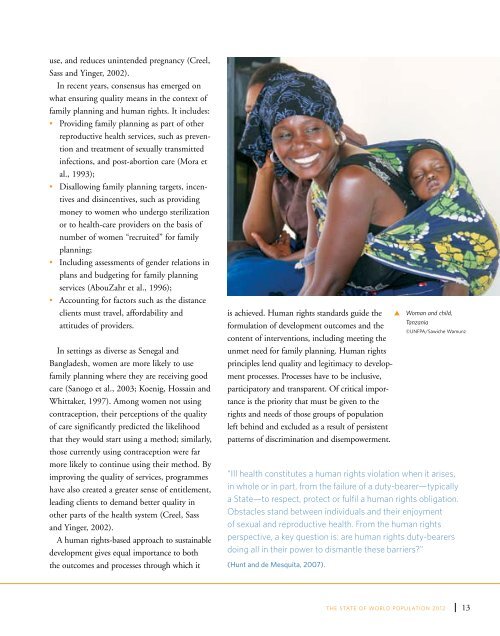State of World Population 2012 - Country Page List - UNFPA
State of World Population 2012 - Country Page List - UNFPA
State of World Population 2012 - Country Page List - UNFPA
Create successful ePaper yourself
Turn your PDF publications into a flip-book with our unique Google optimized e-Paper software.
use, and reduces unintended pregnancy (Creel,<br />
Sass and Yinger, 2002).<br />
In recent years, consensus has emerged on<br />
what ensuring quality means in the context <strong>of</strong><br />
family planning and human rights. It includes:<br />
• Providing family planning as part <strong>of</strong> other<br />
reproductive health services, such as prevention<br />
and treatment <strong>of</strong> sexually transmitted<br />
infections, and post-abortion care (Mora et<br />
al., 1993);<br />
• Disallowing family planning targets, incentives<br />
and disincentives, such as providing<br />
money to women who undergo sterilization<br />
or to health-care providers on the basis <strong>of</strong><br />
number <strong>of</strong> women “recruited” for family<br />
planning;<br />
• Including assessments <strong>of</strong> gender relations in<br />
plans and budgeting for family planning<br />
services (AbouZahr et al., 1996);<br />
• Accounting for factors such as the distance<br />
clients must travel, affordability and<br />
attitudes <strong>of</strong> providers.<br />
In settings as diverse as Senegal and<br />
Bangladesh, women are more likely to use<br />
family planning where they are receiving good<br />
care (Sanogo et al., 2003; Koenig, Hossain and<br />
Whittaker, 1997). Among women not using<br />
contraception, their perceptions <strong>of</strong> the quality<br />
<strong>of</strong> care significantly predicted the likelihood<br />
that they would start using a method; similarly,<br />
those currently using contraception were far<br />
more likely to continue using their method. By<br />
improving the quality <strong>of</strong> services, programmes<br />
have also created a greater sense <strong>of</strong> entitlement,<br />
leading clients to demand better quality in<br />
other parts <strong>of</strong> the health system (Creel, Sass<br />
and Yinger, 2002).<br />
A human rights-based approach to sustainable<br />
development gives equal importance to both<br />
the outcomes and processes through which it<br />
is achieved. Human rights standards guide the<br />
formulation <strong>of</strong> development outcomes and the<br />
content <strong>of</strong> interventions, including meeting the<br />
unmet need for family planning. Human rights<br />
principles lend quality and legitimacy to development<br />
processes. Processes have to be inclusive,<br />
participatory and transparent. Of critical importance<br />
is the priority that must be given to the<br />
rights and needs <strong>of</strong> those groups <strong>of</strong> population<br />
left behind and excluded as a result <strong>of</strong> persistent<br />
patterns <strong>of</strong> discrimination and disempowerment.<br />
t<br />
Woman and child,<br />
Tanzania<br />
©<strong>UNFPA</strong>/Sawiche Wamunz<br />
“Ill health constitutes a human rights violation when it arises,<br />
in whole or in part, from the failure <strong>of</strong> a duty-bearer—typically<br />
a <strong>State</strong>—to respect, protect or fulfil a human rights obligation.<br />
Obstacles stand between individuals and their enjoyment<br />
<strong>of</strong> sexual and reproductive health. From the human rights<br />
perspective, a key question is: are human rights duty-bearers<br />
doing all in their power to dismantle these barriers”<br />
(Hunt and de Mesquita, 2007).<br />
THE STATE OF WORLD POPULATION <strong>2012</strong><br />
13
















